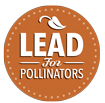By Ayla Sumer, Intern with LEAD for Pollinators, Inc.
To many, honey bees represent a critical indicator of the health of our environment and ecosystems. When dire reports forecasted that honey bee populations were declining, businesses, non-profits, and education programs stepped up, instructing individuals to practice beekeeping and bolster honey bee populations as a method of protecting the environment. As a result of these initiatives, the number of honey bee colonies in the United States increased by 14% from 2020.i However, recent research on the impact of these honey bee-centric pollinator conservation efforts suggests that these endeavors may actually cause more harm than good.
Competition Between Native Bees and Honey Bees
The introduction of non-native honey bee populations into ecosystems increases competition for resources, such as forage, between these honey bees and native bees. Honey bees are highly generalist foragers, collecting pollen from all available plant species. For example, 2 million honey bees collect the equivalent amount of pollen and nectar as 4 million native bees.ii When more honey bee colonies are introduced into an area, these generalist pollinators monopolize flower resources, which creates competition with native bees for specific flowers and plants. Considering that honey bees and native pollinators already face challenges in finding forage due to habitat degradation and other factors, the introduction of honey bees can put even more strain on native bee populations.
Spread of Disease
Additionally, because honey bees are internationally exchanged, they often carry and transfer fatal diseases to native bees, which further weakens native bee populations. According to a 2019 study from the University of Vermont, with the introduction of honey bees to ecosystems, the viruses found in the honey bees transfer to bumble bees and other native bees, through shared usage of flowers.iii Many of the diseases that native bees receive from honey bees can be fatal, such as the deformed wing virus, which results in wing and abdominal abnormalities.
Impacts of Honey Bees on Pollination and Ecosystems
In the past, the impact of introducing honey bees to an overall ecosystem was largely unknown. However, in a 2020 study conducted by the Spanish National Research Council, researchers introduced thousands of honey bee colonies to the Canary Islands, which previously had no honey bee population. After removing these hives, the researchers found that introducing honey bees negatively impacted the relationship between native pollinators and plants and decreased the rate of successful pollination for native plants. Furthermore, the researchers also found that key indicators of ecosystem resilience also declined.iv Overall, this study suggested that the introduction of honey bees can have large-scale, negative impacts on biodiversity and ecosystems.
In the past, scientists believed that the introduction of honey bees into ecosystems produced net benefits for the environment and pollination. However, new research complicates this, suggesting that honey bees can directly harm native bee populations and ecosystems. While honey bees are vital for agricultural and crop pollination, native bees are crucially for effectively pollinating thousands of native plants species and maintaining our ecosystems and biodiversity. In order to preserve native bees, it is necessary to take steps to directly help these populations, including planting habitat, avoiding pesticides, and conducting research on the causes of their decline, rather than focusing our attention solely on honey bees.
—————————————————————-
i. Julia Jacobo, “Nearly 40% decline in honeybee population last winter ‘unsustainable,’ experts say,” ABC News, July 9, 2018, https://abcnews.go.com/US/40-decline-honey-bee-population-winter-unsustainable-experts/story?id=64191609.
ii. “Landmark Report: Hundreds of Native Bee Species Sliding toward Extinction,” Center for Biological Diversity, accessed February 11, 2022, https://www.biologicaldiversity.org/news/press_releases/2017/bees-03-01-2017.php.
iii. J. Seifert, “Neonicotinoids,” Journal of Toxicology, no. 3 (2014): 477-482.
iv. Thomas James Wood, The Environmental Risks of neonicotinoid pesticides: a review of the evidence post-2013 (Cold Spring Harbor, 2017), https://search.proquest.com/docview/2 070155369/2F5C856D20CA419EPQ/12?accountid=36236.

